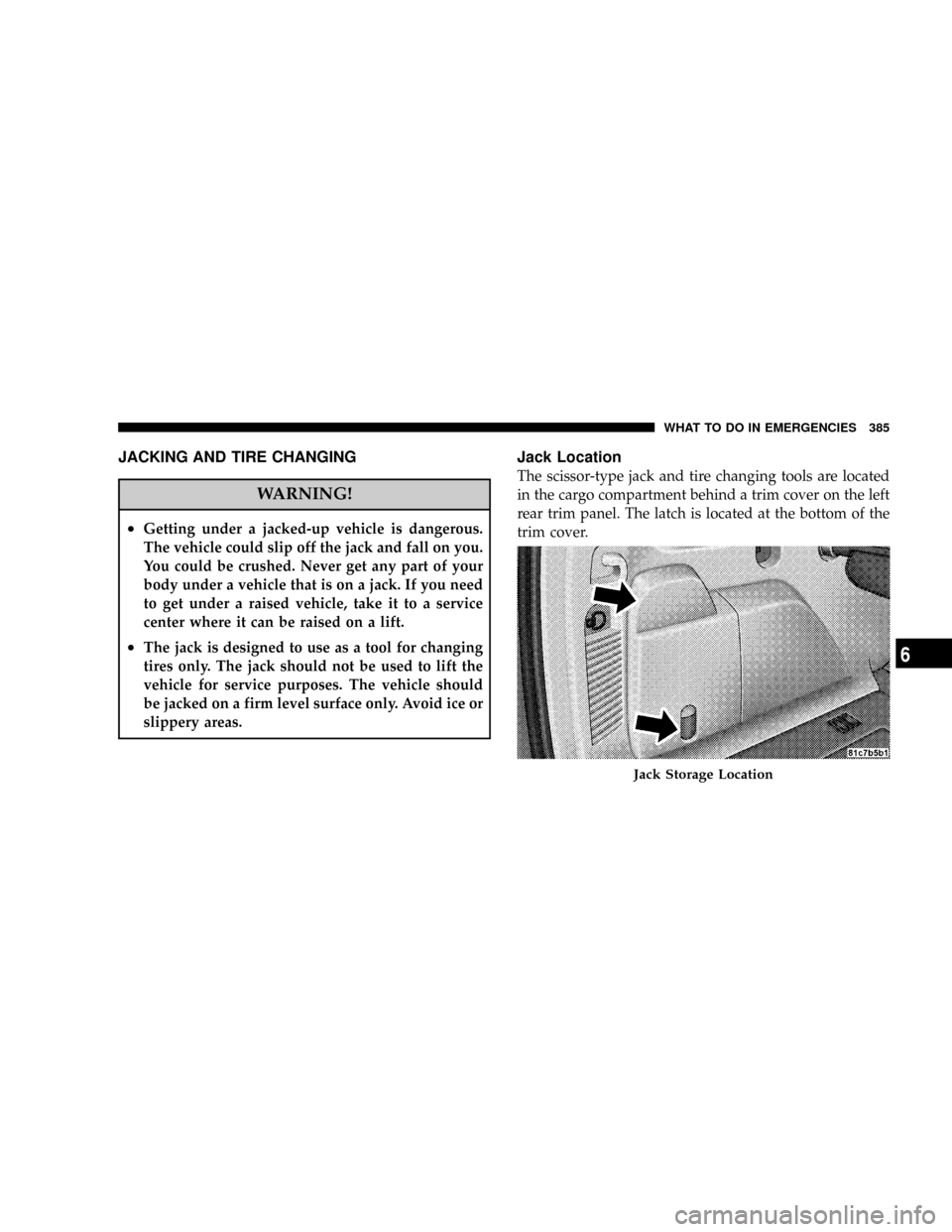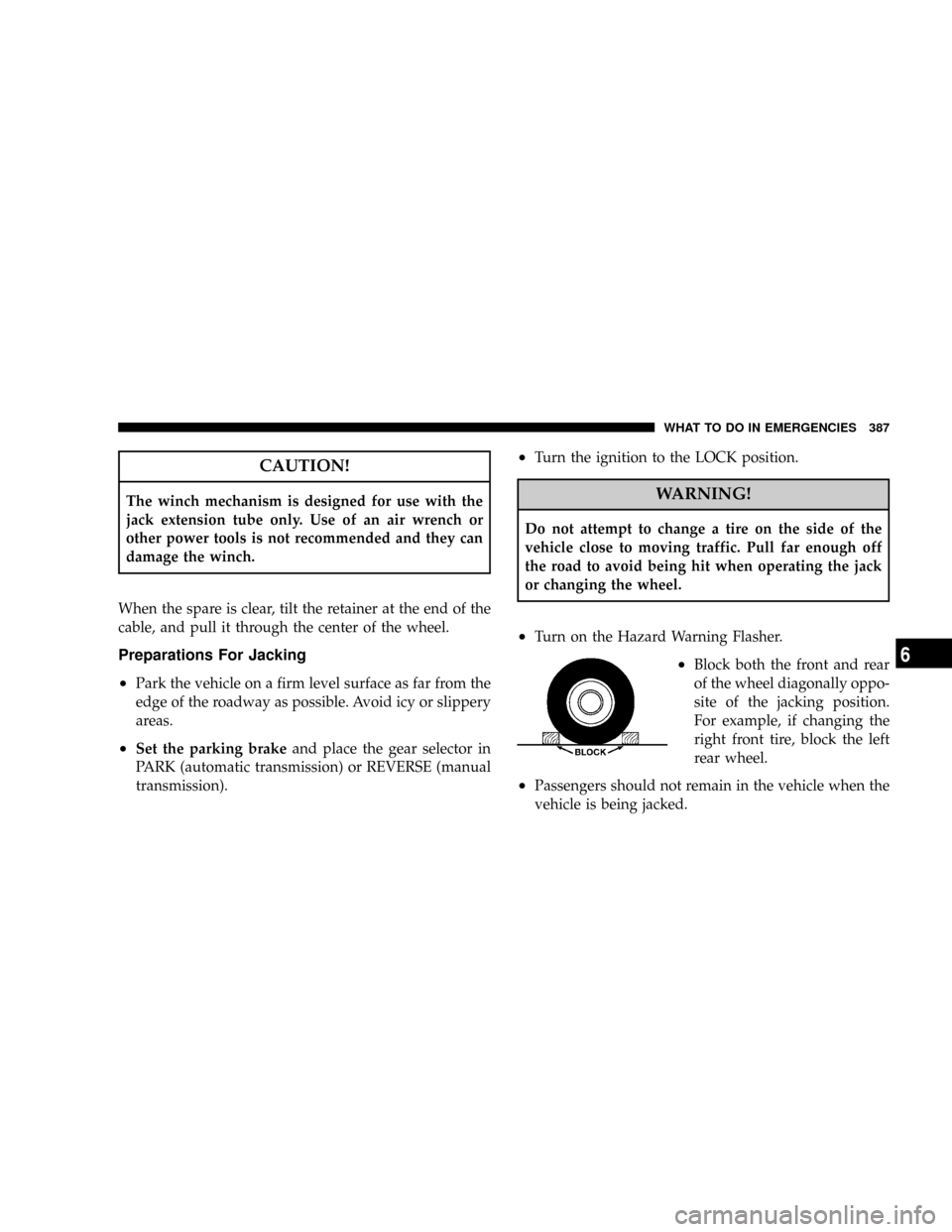JEEP LIBERTY 2008 KK / 2.G Owners Manual
Manufacturer: JEEP, Model Year: 2008, Model line: LIBERTY, Model: JEEP LIBERTY 2008 KK / 2.GPages: 493
Page 381 of 493

²The ignition switch must be in the ON position for a
shift to take place and for the position indicator lights
to be operable. If the ignition switch is not in the ON
position, the shift will not take place and no position
indicator lights will be on or flashing.
²Flashing Neutral (N) position indicator light indicates
that shift requirements have not been met.
CAUTION!
Damage to the transmission may occur if the trans-
mission is shifted into ªPº (Park) with the transfer
case in Neutral (N) and the engine RUNNING. With
the transfer case in Neutral (N), ensure that the
engine is OFF prior to shifting the transmission into
ªPº (Park).
Shifting Out of Neutral (N)
Perform the following procedure to prepare your vehicle
for normal usage:
1. Bring the vehicle to a complete stop.
2. Reconnect the battery negative cable.
3. Place the ignition switch in the LOCK position (if it
has been moved or the engine has been started).
4. Turn the ignition switch to the ON position, but do not
start the engine.
5. Depress the brake pedal.
6. Shift the transmission into ªNº (Neutral) (automatic
transmission), or depress the clutch pedal (manual trans-
mission).
7. Use the point of a ballpoint pen or similar object to
depress the recessed transfer case Neutral (N) button.
Release the Neutral (N) button after the Neutral (N)
STARTING AND OPERATING 381
5
Page 382 of 493

indicator light turns off (approximately 1 second). After
the Neutral (N) button is released, the transfer case will
shift to the position identified by the selector switch.
8. Start the engine.
9. Shift the transmission into ªDº (Drive) (automatic
transmission) or into 1st gear and momentarily release
the clutch (manual transmission) to verify that the trans-
fer case has engaged.
10. Set the parking brake.
11. Shift the transmission into ªPº (Park) (automatic
transmission), or into ªNº (Neutral) (manual transmis-
sion).NOTE:
²Steps 1 through 6 are requirements for shifting the
transfer case. If these requirements not met prior to
depressing the Neutral (N) selection button or while
the shift attempt is in process, then all of the mode
position indicator lights will flash continuously until
all requirements are met or until the Neutral (N)
button is released.
²The ignition switch must be in the ON position for a
shift to take place and for the position indicator lights
to be operable. If the ignition switch in not in the ON
position, the shift will not take place and no position
indicator lights will be on or flashing.
²Flashing Neutral (N) position indicator light indicates
that shift requirements have not been met.
382 STARTING AND OPERATING
Page 383 of 493

WHAT TO DO IN EMERGENCIES
CONTENTS
mIf Your Engine Overheats.................384
mJacking And Tire Changing................385
NJack Location........................385
NSpare Tire Stowage....................386
NSpare Tire Removal....................386NPreparations For Jacking................387
NJacking Instructions....................388
mJump Starting.........................390
mTowing A Disabled Vehicle................393
6
Page 384 of 493

IF YOUR ENGINE OVERHEATS
In any of the following situations, you can reduce the
potential for overheating by taking the appropriate ac-
tion.
²On the highways Ð Slow down.
²In city traffic Ð While stopped, put transmission in N
(Neutral), but do not increase engine idle speed.
NOTE:There are steps that you can take to slow down
an impending overheat condition. If your air conditioner
is on, turn it off. The air conditioning system adds heat to
the engine cooling system and turning off the A/C
removes this heat. You can also turn the Temperature
Control to maximum heat, the Mode Control to floor, and
the Fan Control to High. This allows the heater core to act
as a supplement to the radiator and aids in removing heat
from the engine cooling system.
CAUTION!
Driving with a hot cooling system could damage
your vehicle. If the temperature gauge reads ªH,º
pull over and stop the vehicle. Idle the vehicle with
the air conditioner turned off until the pointer drops
back into the normal range. If the pointer remains on
the ªH,º and you hear continuous chimes, turn the
engine off immediately, and call for service.
384 WHAT TO DO IN EMERGENCIES
Page 385 of 493

JACKING AND TIRE CHANGING
WARNING!
²Getting under a jacked-up vehicle is dangerous.
The vehicle could slip off the jack and fall on you.
You could be crushed. Never get any part of your
body under a vehicle that is on a jack. If you need
to get under a raised vehicle, take it to a service
center where it can be raised on a lift.
²The jack is designed to use as a tool for changing
tires only. The jack should not be used to lift the
vehicle for service purposes. The vehicle should
be jacked on a firm level surface only. Avoid ice or
slippery areas.
Jack Location
The scissor-type jack and tire changing tools are located
in the cargo compartment behind a trim cover on the left
rear trim panel. The latch is located at the bottom of the
trim cover.
Jack Storage Location
WHAT TO DO IN EMERGENCIES 385
6
Page 386 of 493

Spare Tire Stowage
The spare tire is stowed underneath the rear of the
vehicle and is held in place by a cable winch mechanism.
Spare Tire Removal
Fit the jack handle extension over the drive nut. Use the
Lug Wrench to rotate the nut counter clockwise until the
spare is on the ground with enough slack in the cable to
allow you to pull the tire out from under the vehicle.
Lowering/Raising Spare Tire
386 WHAT TO DO IN EMERGENCIES
Page 387 of 493

CAUTION!
The winch mechanism is designed for use with the
jack extension tube only. Use of an air wrench or
other power tools is not recommended and they can
damage the winch.
When the spare is clear, tilt the retainer at the end of the
cable, and pull it through the center of the wheel.
Preparations For Jacking
²
Park the vehicle on a firm level surface as far from the
edge of the roadway as possible. Avoid icy or slippery
areas.
²Set the parking brakeand place the gear selector in
PARK (automatic transmission) or REVERSE (manual
transmission).
²Turn the ignition to the LOCK position.
WARNING!
Do not attempt to change a tire on the side of the
vehicle close to moving traffic. Pull far enough off
the road to avoid being hit when operating the jack
or changing the wheel.
²Turn on the Hazard Warning Flasher.
²Block both the front and rear
of the wheel diagonally oppo-
site of the jacking position.
For example, if changing the
right front tire, block the left
rear wheel.
²Passengers should not remain in the vehicle when the
vehicle is being jacked.
WHAT TO DO IN EMERGENCIES 387
6
Page 388 of 493

Jacking Instructions
1. Remove spare tire.
2. Loosen (but do not remove) the wheel lug nuts by
turning them to the left one turn while the wheel is still
on the ground.
3. Remove jack and tools from mounting bracket. As-
semble the tools by connecting the driver to the exten-
sion, and then to the lug wrench.
4. Locate the jack as shown. For the front tires, place it in
the notch on the body weld seam behind wheel to be
changed. For the rear tires, place it under the axle by the
wheel to be changed. Position the jack handle on the jack.
Do not raise the vehicle until you are sure the jack is
fully engaged.
Front Jacking Location
388 WHAT TO DO IN EMERGENCIES
Page 389 of 493

5. Raise the vehicle by turning the jack screw to the right.
Raise the vehicle only until the tire just clears the surface
and enough clearance is obtained to install the spare tire.
Minimum tire lift provides maximum stability.
WARNING!
Raising the vehicle higher than necessary can make
the vehicle less stable and cause an accident. It could
slip off the jack and hurt someone near it. Raise the
vehicle only enough to remove the tire.
6. Remove the lug nuts and wheel.
7. Position the spare wheel/tire on the vehicle and install
lug nuts with cone-shaped end toward wheel. Lightly
tighten the nuts. To avoid the risk of forcing the vehicle
off the jack, do not tighten the nuts fully until the vehicle
has been lowered.
8. Lower the vehicle by turning the jack screw to the left,
and remove the jack and wheel blocks.
9. Finish tightening the lug nuts. Push down on the
wrench while tightening for increased leverage. Alternate
Rear Jacking Location
WHAT TO DO IN EMERGENCIES 389
6
Page 390 of 493

nuts until each nut has been tightened twice. Correct
wheel nut tightness is 130 N´m (95 ft. lbs). If in doubt
about the correct tightness, have them checked with a
torque wrench by your authorized dealer or at a service
station.
10. Lower the jack to it's fully closed position.
WARNING!
A loose tire or jack, thrown forward in a collision or
hard stop could endanger the occupants of the ve-
hicle. Always stow the jack parts and the spare tire in
the places provided.
11. Secure the tire, jack, and tools in their proper loca-
tions.
JUMP STARTING
WARNING!
²Take care to avoid the radiator cooling fan whenever the hood is
raised. It can start anytime the ignition switch is on. You can be hurt
by the fan.
²Do not attempt to push or tow your vehicle to get it started. Vehicles
equipped with an automatic transmission cannot be started this
way. Unburned fuel could enter the catalytic converter and once the
engine has started, ignite and damage the converter and vehicle. If
the vehicle has a discharged battery, booster cables may be used to
obtain a start from another vehicle. This type of start can be
dangerous if done improperly, so follow this procedure carefully.
²Battery fluid is a corrosive acid solution; do not allow battery fluid
to contact eyes, skin, or clothing. Don't lean over battery when
attaching clamps or allow the clamps to touch each other. If acid
splashes in eyes or on skin, flush contaminated area immediately
with large quantities of water.
²A battery generates hydrogen gas, which is flammable and explo-
sive. Keep flame or spark away from the vent holes.
²Do not use a booster battery or any other booster source with an
output that exceeds 12 volts.
390 WHAT TO DO IN EMERGENCIES